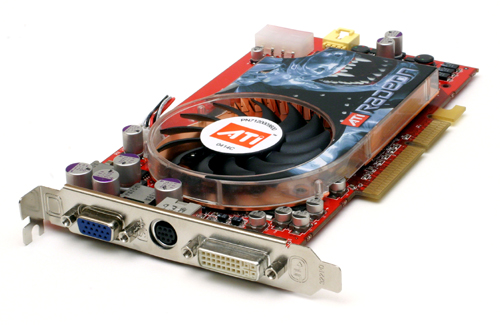ATI Radeon X800 Pro and XT Platinum Edition: R420 Arrives
by Derek Wilson on May 4, 2004 10:28 AM EST- Posted in
- GPUs
Introduction
Today we herald the release of the new ATI graphics solution. Though the R420 is still based on DX9's PS2.0, performance numbers look to be on par with what we would expect from a company who has lead the industry in performance for nearly two years. The two new board configurations based on R420 at which we will be looking today are the Radeon X800 Pro, and the Radeon X800 XT Platinum Edition. The Radeon X800 Pro is shipping today, but the XT Platinum Edition won't make it out the door until later this month (ATI cites May 21st as the shipping date).

We were skeptical, when the GeForce 6800 Ultra was thrust into the spotlight, that ATI would be able to keep up with their toughest competitor. From the first briefing we had regarding the R420 GPU, we knew it would be an intense fight. Both the NV40 and R420 architectures are very sound and well founded, and the next six months will be a very good time for consumers of computer technology. But before we start handing out the nominations for happiest customer, let's take a look at the new kid on the block.










95 Comments
View All Comments
Pumpkinierre - Wednesday, May 5, 2004 - link
Sorry, scrub that last one. I couldnt help it. I will reform.Pumpkinierre - Wednesday, May 5, 2004 - link
So, which is better: a64 at 2Gig or P4 at 3.2?jibbo - Wednesday, May 5, 2004 - link
"Zobar is right; contra Jibbo, the increased flexibility of PS3 means that for many 2.0 shader programs a PS3 version can achieve equivalent results with a lesser performance hit."I think you're both still missing my point. There is nothing that says PS3.0 is faster than PS2.0. You are both correct that it has to potential to be faster, though you both assume that a first generation PS3.0 architecture will perform at the same level as a refined PS2.0 architechture.
PS3.0 is one of the big reasons that nVidia's die size and transistor count are bigger than ATI's. The additional power drain (and consequently heat dissipation) of those 40M transistors also helps to limit the clock speeds of the 6800. When you're talking about ALU ops per second (which dominate math-intensive shaders), these clock speeds become very important. A lot of the 6800's speed for PS3.0 will have to be found in the driver optimizations that will compile these shaders for PS3.0. Left to itself, ATI's raw shader performance still slaughters nVidia's.
They both made trade-offs, and it seems that ATI is banking that PS3.0 won't be a dealbreaker in 2004. Only time will tell....
Phiro - Wednesday, May 5, 2004 - link
K, I found the $400M that the CEO claimed. He also claimed $400M for the NV3x core as well. It seemed more as a boast than anything, not particularly scientific or exact.In any case, ATI supposedly spent $165-180M last year (2003) on R&D, with an estimated increase of 100% for this year. How long has the 4xx core been in development?
Regardless, ultimately we the consumers are the winners. Whether or not the R&D spent pans out will play out over the next couple years, as supposedly the nv4x core has a 24 month lifespan.
413xram - Wednesday, May 5, 2004 - link
If you watch nvidia's launch video on their site they mention the r&d costs for their new card.RyanVM - Wednesday, May 5, 2004 - link
What ever happened to using ePSXe as a video card benchmark?Phiro - Wednesday, May 5, 2004 - link
Well, Nvidia may have spent $400M on this (I've never seen that number before but we'll go with it I guess) but they paid themselves for the most part.ATI's cost can't be too trivialized - didn't they drop a product design or two in favor of getting this out the door instead? And any alteration in the architecture of something doesn't really qualify as a hardware "refresh" in my book - a hardware refresh for an OEM consists of maybe one speed notch increase in the RAM, new bios, larger default HD, stuff like that. MLK is what Dell used to call it - Mid Life Kick.
retrospooty - Wednesday, May 5, 2004 - link
"Precisely. By the time 512mb is useful, the card will be too slow for it to matter, and you'd need a new card any way."True...
Both cards perform great, both have wins and losses depending on the game. The deciding factor will be price and power requirements.
Since prices will adjust downward, at a fairly equal rate, that leaves power. With Power requirements being so incredibly high with the NV40, that leans me toward ATI.
413xram also has a good point above. For Nvidia, this is a 400 million dollar new chip design. For ATI, this was a refresh of an old design to add 16 pipes, and a few other features. After the losses NV took with the heavily flawed NV30 and 35 , they need a financial boom, and this isnt it.
mattsaccount - Wednesday, May 5, 2004 - link
There are no games available today that use 256mb of video RAM, let alone 512mb. Even upper-high-end cards routinely come with 128mb (e.g. Geforce FX 5900, Radeon 9600XT). It would not make financial sense for a game developer to release a game that only a small fraction of the community could run acceptably.>> I have learned from the past that future possibilties of technology in hardware does nothing for me today.
Precisely. By the time 512mb is useful, the card will be too slow for it to matter, and you'd need a new card any way.
413xram - Wednesday, May 5, 2004 - link
#64 Can you explain "gimmick"?